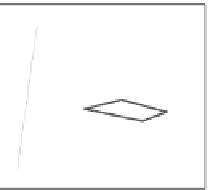Graphics Reference
In-Depth Information
R
t
R(-45
o
)
S(0.5,2)
R
r
R
r
T(3,-5)
R
s
R
i
R
s
45
o
M
−
1
Figure 9.4.
n
1
: the inverse transform of
M
n
1
.
9.3
Pivoted Transformations
We are now ready to address the concerns brought up by the illustrations of Fig-
ure 8.9 and Figure 8.16. Recall that in these cases, we observed unexpected mov-
ing side effects from the scaling and rotation operators. This moving side effect
hinders the effectiveness of these operators where the results of the operation de-
pend upon the initial positions of the vertices. We are now ready to address this
side effect by working with concatenation of operators.
Figure 9.5 uses the same four vertices as in Figure 8.9 to illustrate how to
accomplish the more intuitive scaling operation by strategically combining trans-
lation and scaling operators. In Figure 9.5, we first apply the T
(
−
1
,−
5
)
operator
followed by the S
(
3
,
0
.
5
)
operator on the four corners of the input rectangle
R
i
,
where:
⎧
⎨
⎩
V
a
=(
3
,
8
)
,
V
b
=(
1
,
8
)
,
Input points:
V
c
=(
1
,
5
)
,
V
d
=(
,
)
.
3
5
The result of the translate operation is rectangle
R
t
:
⎧
⎨
V
at
=(
2
,
3
)
,
V
bt
=(
0
,
3
)
,
Output from translation:
⎩
=(
,
)
,
V
ct
0
0
V
dt
=(
,
)
.
2
0
Here we notice that the translated rectangle has the left (
e
bct
) and the bottom edges
(
e
cdt
) reside along the
y
-and
x
-axes. The following serve as input to the scaling
operation:
•
Edge
e
bct
.
This is the edge formed by vertices
V
bt
and
V
ct
. By definition, all
vertices on the
y
-axis have value 0 for the
x
-coordinate. Recall that the scal-
ing operator resizes by multiplying the scaling factor
s
x
by the
x
-coordinate




































































































































































































































































































Search WWH ::

Custom Search